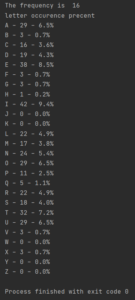You will learn how to calculate the frequency and percentage of a given letter in a text file using Python, working with strings loaded from an external file.

Frequency of given letter
file = open('text.txt', 'r')
text: str = file.read()
file.close()
def frequency(txt, sign):
counter: int = 0
for s in txt:
if s != sign:
continue
counter += 1
return counter
print('The frequency is ', frequency(text.lower(), 'c'))
The first line opens the text file in read mode. The second line reads the text from the file and stores it in the text variable. The third line closes the file to free up the memory.
The frequency function iterates over the text and counts the number of times the given letter appears. The counter variable is incremented every time the letter is found.
The last line prints the frequency of the letter c.
Frequency and percentage of given letter
file = open('text.txt', 'r')
text: str = file.read()
file.close()
def letter_stats(txt, sign):
txt_lower = txt.lower()
total_chars = len(txt_lower)
counter: int = 0
for s in txt_lower:
if s == sign:
counter += 1
frequency = counter
percentage = (frequency / total_chars) * 100 if total_chars > 0 else 0
return frequency, percentage
frequency_c, percentage_c = letter_stats(text, 'c')
print(f'The frequency of "c" is: {frequency_c}')
print(f'The percentage of "c" is: {percentage_c:.2f}%')
The enhanced letter_stats function now calculates both the frequency and the percentage of a specific character in the text, giving you letter statistics for any Python string or file content. First, it converts the input text to lowercase and calculates the total number of characters. Then, it iterates through the lowercase text, counting occurrences of the target character. Finally, it calculates the percentage by dividing the frequency by the total character count and multiplying by 100. The function returns both the frequency and the percentage, which are then printed to the console.
For robustness, consider adding error handling to your code. For instance, you might want to use a try…except block to handle potential FileNotFoundError if the text.txt file does not exist in the specified location. Furthermore, when opening files, it’s best practice to use a with open(…) as file: statement. This ensures that the file is automatically closed even if errors occur. For specifying file paths, especially if your script might run on different operating systems, using os.path.join() to construct file paths is recommended for platform independence.
